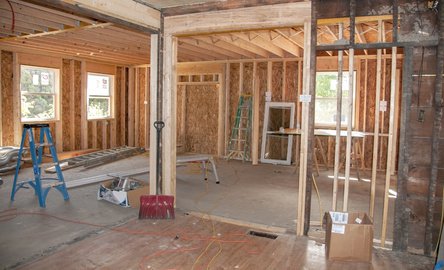No doubt there are numerous advantages to adding on to your home: increased living space, room for a growing family, additional sunlight, increased home value, etc. And while many times the purpose of your addition or the specific space you are dealing with will determine how and where you add on, many times you have the option – to build out or to build up? There are advantages and disadvantages to each, so before you decide what is best for your home, consider the following:
Building Out
The majority of home additions occur on the first floor. Building out just makes more sense for additions to the kitchen, the living room, or is more affordable if the house is a single-story. The large pieces to this project include digging up the yard where the addition will be, installing a new foundation or slab, and opening up the existing exterior where it will link the new construction.
Pros- One of the biggest advantages to building out is that it entails the least amount of disruption to your home and daily life. For the most part, the construction will take place outside your existing space. Additionally, for smaller additions, you may be able to do a bump out, which means you would not need additional foundation or slab work.
Cons- The first obvious disadvantage is that you’d be losing some of your yard space, so you need to weigh this loss against the advantage of increased square-footage of your home. Secondly, you may run into zoning issues if you’re within the property line setback, which dictates how far your home must be from your neighbor’s property. You also need to check your city’s limitations when it comes to Floor-Area-Ratio rating. This sets forth what percentage of a lot can be built on. But an experienced contractor will be able to help you with all of these logistical issues.
Building Up
Building out, however, is not the only option. Whether you live in a one story and want to add a second level, or if you are already in a two-story home and want to expand that second floor, building up is often a viable and advantageous option. In this case, the contractor would have to expose the foundation and wall structure in order to reinforce and strengthen the existing space to be able to support the new additional weight.
Pros- Gaining without losing. When you build up, you gain square-footage to your home without losing any yard space. You also don’t have to worry about limitations like Floor-Area-Ratio and property line setbacks.
Cons- As you can imagine, there is generally a lot more invasive construction involved with building up. Walls and ceilings have to be torn up to add more structural support as well as to connect all the appropriate electrical, plumbing and heating lines. If you’re adding a second story to an existing single-story home, then you also have to account for the stairwell which can take up to 120 square feet or more of your living space. Lastly, you may run into issues with high allowance. You’ll need to check your city’s ordinances.
As you can see, there is no one right answer. Each house will have it’s own unique set of benefits and limitations. Whether you’re considering building out or building up, to discuss your home addition with experienced professionals, please visit us at https://murfeycompany.com.

